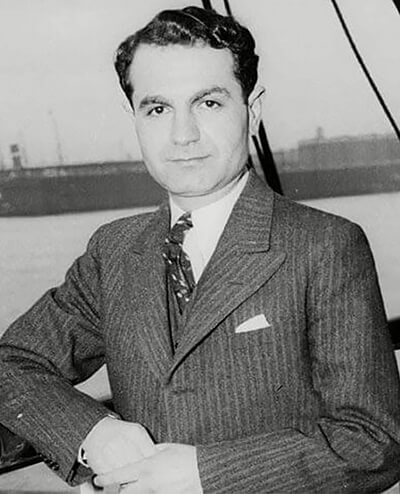Death of Luther Simjian (October 23, 1997)

Luther George Simjian, an Armenian American prolific inventor and entrepreneur, held over 200 patents and had a pioneering flight simulator, the first ATM, and improvements to the teleprompter among his most significant inventions.
Լuther Simjian was born in Aintab (Cilicia) on January 28, 1905. He lost his mother when he was only a few months old; his father later remarried and had two daughters. The family fled to Aleppo during the Genocide and only returned to Aintab in 1920 during the brief French mandate over Cilicia. Simjian’s stepmother and half-sisters were killed in Marash. Eventually he escaped to Beirut and then came to the United States via France at the end of 1920. He first settled in New Haven, Connecticut, where he lived with an uncle and graduated from Booth Preparatory School.
Simjian began working as a technician at the photography lab of the Yale School of Medicine. In 1928 he founded and became the first director of the photography department, which he headed until 1934. He resigned from Yale and moved to New York, where he took courses at Columbia University focusing on business education, writing, and international banking.
His interest in portrait photography led to him inventing a self-photographing camera. He applied for a patent in 1929 and set up a company named PhotoReflex after the camera. The self-photographing camera led to the invention of the autofocus (self-focusing) camera by Simjian. He was granted a patent in July 1932. It changed the whole photography industry and, even though he did not receive much money for his invention, he did get publicity. In June 1934 he was granted a patent for a color X-ray machine. He married in 1936 to Gladys Cannon, and they had two children.
In 1939 Simjian founded Reflectone Corporation (later renamed Reflectone Electronics, Inc.) in Stamford, Connecticut, to develop and manufacture his inventions. He served as president and chairman until he sold the company to Universal Match Corporation in 1961.
One of the first inventions in Reflectone was a rotating chair with a movable mirror to be used for women when applying cosmetics. Simjian also invented a method to develop a photo immediately, while still preserving the negative.
During World War II, he invented a training apparatus for aviators, which was the first flight simulator of its kind. He was granted a patent in January 1946. Reflectone sold over 2,000 of these devices to the U.S. military. The company grew exponentially to manufacture the orders for this trainer with the number of employees rising from three to 250 by 1950.
After Reflectone, Simjian founded General Research Inc. and Command Automation Inc.; the latter was a research and development lab in Fort Lauderdale, Florida. His later inventions were increasingly diverse and eclectic. Between 1956 and 1963, he received some 75 patents, making it his most prolific period.
Simjian held a patent on the teleprompter. However, he was not its sole inventor. Simjian and Jess Oppenheimer, the creator and producer of the classic sitcom I Love Lucy, improved the original mechanical device and replaced it with an optical teleprompter.
Simjian invented what has been described as a precursor of the automated teller machine (ATM). For this, Simjian is often considered its inventor or the person who first introduced the concept. His role in the invention is disputed, but he is recognized as the inventor of a photomechanical automated banking terminal, popularly known as the Bankograph. He was granted over 20 patents for it.
The Bankograph was an automatic deposit machine that always accepted cash and check deposits. A camera inside the machine took snapshots of the deposits and their copies were given to the customers as receipts. It was introduced to the wider public in 1961, when it was placed in a few lobbies of Citibank, but its use was discontinued due to limited appeal. The New York Times wrote in 1998 that it was Simjian’s most famous invention and “the basis for the now-ubiquitous A.T.M., from which he never made a penny.”
Simjian’s other inventions included an indoor computerized golf practice range (1960s), an exercise bicycle that massages the rider (1973), a golf training aid to improve putting (1981), a remotely accessed automatic postage meter (1981) that was purchased by Pitney Bowes, a meat tendering method, the use of ultrasound as an anticounterfeiting device, and other devices. His eyesight declined significantly in his last years. But he still made inventions and was granted his last patent in March 1997, seven months before his death on October 23, 1997, at the age of 92, in Fort Lauderdale.
